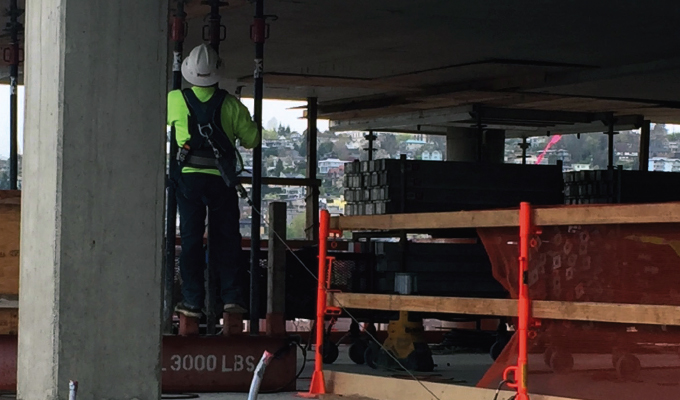When I started my construction career, my work was a passion, it was a challenge, but most of all, it was a discipline. I got to know my tools, their capabilities, and their safety features. I worked with many systems, and I continually questioned why the safety of the end user wasn’t the priority.
For the last 25-plus years, I have workedseveral notable projects. But one project but one project forever changed me from a carpenter to an entrepreneur: Five Hundred Capitol Mall (also known as Bank of the West Tower) in Sacramento, California. On that project, a guardrail post became dislodged during a tightening adjustment, and the bottom half of the unit fell more than 17 floors. I had witnessed many accidents in the construction industry before, but this time, I refused to accept that such failures were unavoidable. I developed a surface-mounted guardrail system with a positive, threaded anchorage system and a dedicated D-ring for a tie-off point. In 2014, my work was recognized when I was awarded U.S. Patent No. 8,656,652 for the Safety Anchor Post System (SAPS).
HOW DOES SAPS WORK?
Guardrails and the supporting posts must be designed to meet Section 1910.29 of the Occupational Safety and Health Administration (OSHA) standards, and fall arrest systems must be designed to meet Section 1910.15 of the OSHA standards. While guardrail posts are required to resist 200 lb (890 N) loads, anchorages for fall arrest systems (fixed D-rings for lanyard tie-off) are required to resist at least 5,000 lb (22.24 kN) per worker attached. Of course, to be effective, any protection system also must be user friendly and ergonomic.
To achieve the tall order of meeting the requirements of both OSHA sections as well as being simple to use, my guardrail post system had to be:
- Anchored within the concrete slab
- Rapidly installed and removed
- Reusable
The solution—use an embedded threaded anchor and an engineered guardrail post with an integral threaded anchor rod. I designed a system with anchors sized to fit slabs ranging from 6 to 24 inches in thickness. By using an embedded anchor, the SAPS system protects reinforcing bars and post-tensioning tendons from damage that might occur if anchors were installed in drilled holes instead.
To meet the OSHA requirements, SAPS anchors must be installed no closer than 1 ft from the slab edge and spaced at no more than 8 feet on center. Once the anchors are secured to the formwork, post-tensioning tendons, reinforcing bars, and concrete can be placed. The SAPS anchors are ready for use after the concrete reaches a compressive strength of 2500 psi. The workers simply remove the antenna plug and thread the SAPS coil rod into the embedded anchor. A SAPS post can be installed in under 30 seconds, without the need for a single tool.
CLOSING THOUGHT
My vision for the SAPS is to meet and exceed our clients’ needs with an engineered system designed with our core. We recognize that People are the most valuable assets to a company, that Profit is why the business exists, and that our guardrails help to protect the Planet because they are removable and recyclable. I am privileged to visit many projects and see firsthand how the SAPS is revolutionizing safety for my clients.
Intertek Tested ANSI Z359.18-2017 Safety Requirements for Anchorage Connectors for Active Fall Protection Systems
About the Author:
Jose M. (Manny) Carrillo is the CEO of Safety Anchor Post System. He has more than 35 years of experience in the construction industry. His formal construction career began as a carpenter apprentice in Southern California, where he quickly became fascinated with concrete forms and mega structures. For more, visit www.safetyanchorpost.com.
Modern Contractor Solutions, February 2022
Did you enjoy this article?
Subscribe to the FREE Digital Edition of Modern Contractor Solutions magazine.



